Books
Books

Un Rectangle Quelconque n°5
Tomas Sidoli, Emmanuel Régniez and 1 more
Avec les poèmes et traductions de: Warsan Shire, Sika Fakambi, Anne-Claire Hello, Aurore Dal Mas, Connie Scozzaro, Chloe Chignell, Camille Fresnois, Simon Asencio, Marie De Quatrebarbes.
Aves les images de Aurore Dal Mas.
Édition: Thomas Le Goff, Emmanuel Régniez, Tomas Sidoli.
Les éditions du quelconque se divisent en deux projets, une maison d'édition (à venir) et une revue, Un Rectangle Quelconque. Cette dernière, chaque semestre, propose de découvrir des auteurs de poésie venant de tous horizons géographiques et esthétiques. La maison d'édition, elle, sera l'occasion de présenter aux lecteurs francophones des nouvelles voix de la poésie actuelle.
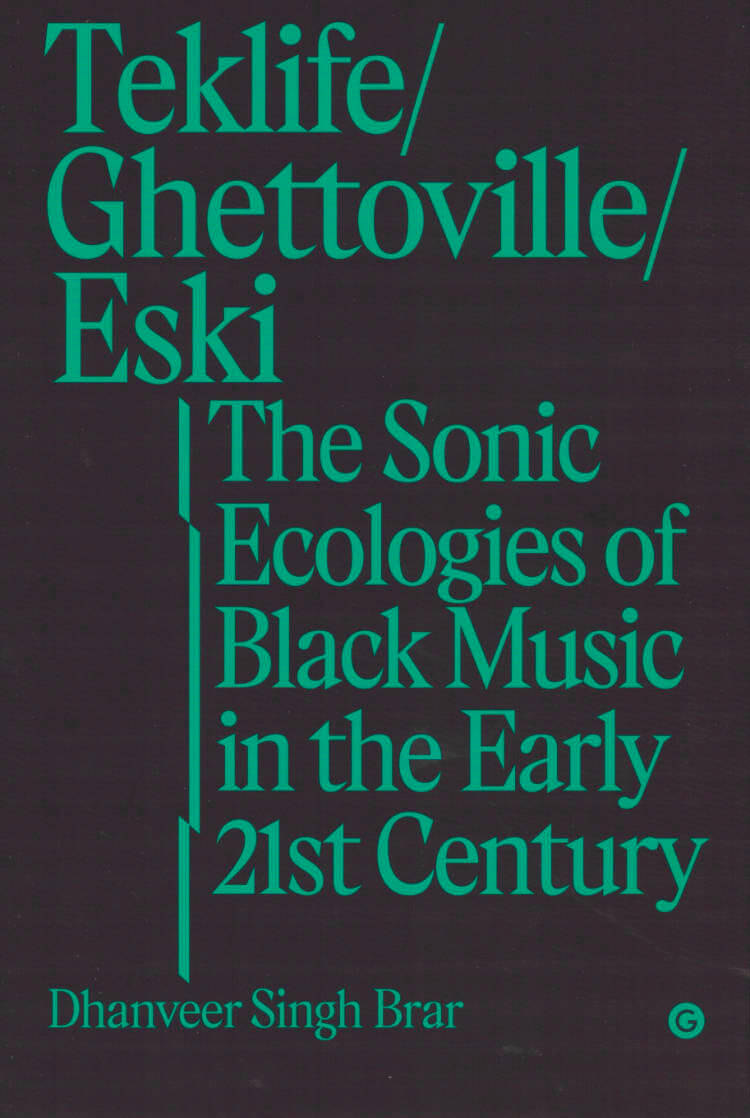
Teklife, Ghettoville, Eski: The Sonic Ecologies of Black Music in the Early 21st Century
Teklife, Ghettoville, Eski argues that Black electronic dance music produces sonic ecologies of Blackness that expose and reorder the contemporary racialization of the urban—ecologies that can never simply be reduced to their geographical and racial context. Dhanveer Singh Brar makes the case for Black electronic dance music as the cutting-edge aesthetic project of the diaspora, which due to the music's class character makes it possible to reorganize life within the contemporary city.
Closely analysing the Footwork scene in South and West Chicago, the Grime scene in East London, and the output of the South London producer Actress, Brar pays attention to the way each of these critically acclaimed musical projects experiment with aesthetic form through an experimentation of the social. Through explicitly theoretical means, Teklife, Ghettoville, Eski foregrounds the sonic specificity of 12 records, EPs, albums, radio broadcasts, and recorded performances to make the case that Footwork, Grime, and Actress dissolve racialized spatial constraints that are thought to surround Black social life.
Pushing the critical debates concerning the phonic materiality of blackness, undercommons, and aesthetic sociality in new directions, Teklife, Ghettoville, Eski rethinks these concepts through concrete examples of contemporary black electronic dance music production that allows for a theorization of the way Footwork, Grime, and Actress have—through their experiments in blackness—generated genuine alternatives to the functioning of the city under financialized racial capitalism.

The Mill
The Mill is the second of three projects to engage the resource industries of Vancouver Island (mining, forestry, and fisheries) through contemporary art and writing. This publication responds to forestry: a mobile industry of logging camps that follow the trees; prices that rise and fall; mills that open and close; communities that boom and bust. In The Mill, artworks are accompanied by a multiplicity of voices, including forestry workers, plant ecologists, and indigenous land stewards. Together, these perspectives chart the cultural and material shifts brought about when trees become commodities.
The Mill is a project that emerged on Vancouver Island to follow a thematic path from the microcosms of the forest floor to the quantifying and processing of lumber and the global distribution of forestry products. Expanded from two exhibitions at the Nanaimo Art Gallery, “Silva Part I: O Horizon” and “Silva Part II: Booming Grounds,” this book examines forgotten or under-acknowledged histories, while considering both local sites and forms of cultural expression that surround international forestry practices.
Contributions by Celestine Aleck, E. Richard Atleo (Umeek), Marian Penner Bancroft, Myrtle Bergren, Al Bersch & Leslie Grant, Peter Culley, Wilmer Gold, Bus Griffiths, Robert Guest, Jason de Haan & Miruna Dragan, Richard Hebda, Robin Wall Kimmerer, Ursula K. Le Guin, Duane Linklater, Liz Magor, George Sawchuk, Carol Sawyer, W. G. Sebald, Kathy Slade, Kate Stefiuk, Kika Thorne, Nancy Turner, Fred Wah, Elias Wakan, Merv Wilkinson, Anne Pask-Wilkinson, Ashes Withyman.
Graphic design: Will Holder.

Tomb(e)
"In 1968-69 I wanted to die, that is to say, stop living, being killed, but it was blocked on all sides," wrote Hélène Cixous, esteemed French feminist, playwright, philosopher, literary critic, and novelist. Instead of suicide, she began to dream of writing a tomb for herself. This tomb became a work that is a testament to Cixous's life and spirit and a secret book, the first book she ever authored. Originally written in 1970, Tombe is a Homerian recasting of Shakespeare's Venus and Adonis in the thickets of Central Park, a book Cixous provocatively calls the "all-powerful-other of all my books, it sparks them off, makes them run, it is their Messiah."
Masterfully translated by Laurent Milesi, Tombe preserves the sonic complexities and intricate wordplay at the core of Cixous's writing, and reveals the struggles, ideas, and intents at the center of her work. With a new prologue by the author, this is a necessary document in the development of Cixous's aesthetic as a writer and theorist, and will be eagerly welcomed by readers as a crucial building block in the foundation of her later work .

The Care Manifesto: The Politics of Interdependence
The Care Manifesto puts care at the heart of the debates of our current crisis: from intimate care—childcare, healthcare, elder care—to care for the natural world. We live in a world where carelessness reigns, but it does not have to be this way.
The Care Manifesto puts forth a vision for a truly caring world. The authors want to reimagine the role of care in our everyday lives, making it the organising principle in every dimension and at every scale of life. We are all dependent on each other, and only by nurturing these interdependencies can we cultivate a world in which each and every one of us can not only live but thrive.
The Care Manifesto demands that we must put care at the heart of the state and the economy. A caring government must promote collective joy, not the satisfaction of individual desire. This means the transformation of how we organise work through co-operatives, localism and nationalisation. It proposes the expansion of our understanding of kinship for a more 'promiscuous care'. It calls for caring places through the reclamation of public space, to make a more convivial city. It sets out an agenda for the environment, most urgent of all, putting care at the centre of our relationship to the natural world.

The Ontology of the Accident: An Essay on Destructive Plasticity
In the usual order of things, lives run their course and eventually one becomes who one is. Bodily and psychic transformations do nothing but reinforce the permanence of identity. But as a result of serious trauma, or sometimes for no reason at all, a subject's history splits and a new, unprecedented persona comes to live with the former person - an unrecognizable persona whose present comes from no past and whose future harbors nothing to come; an existential improvisation, a form born of the accident and by accident. Out of a deep cut opened in a biography, a new being comes into the world for a second time.
What is this form? A face? A psychological profile? What ontology can it account for, if ontology has always been attached to the essential, forever blind to the aléa of transformations? What history of being can the plastic power of destruction explain? What can it tell us about the explosive tendency of existence that secretly threatens each one of us?
Continuing her reflections on destructive plasticity, split identities and the psychic consequences experienced by those who have suffered brain injury or have been traumatized by war and other catastrophes, Catherine Malabou invites us to join her in a philosophic and literary adventure in which Spinoza, Deleuze and Freud cross paths with Proust and Duras.
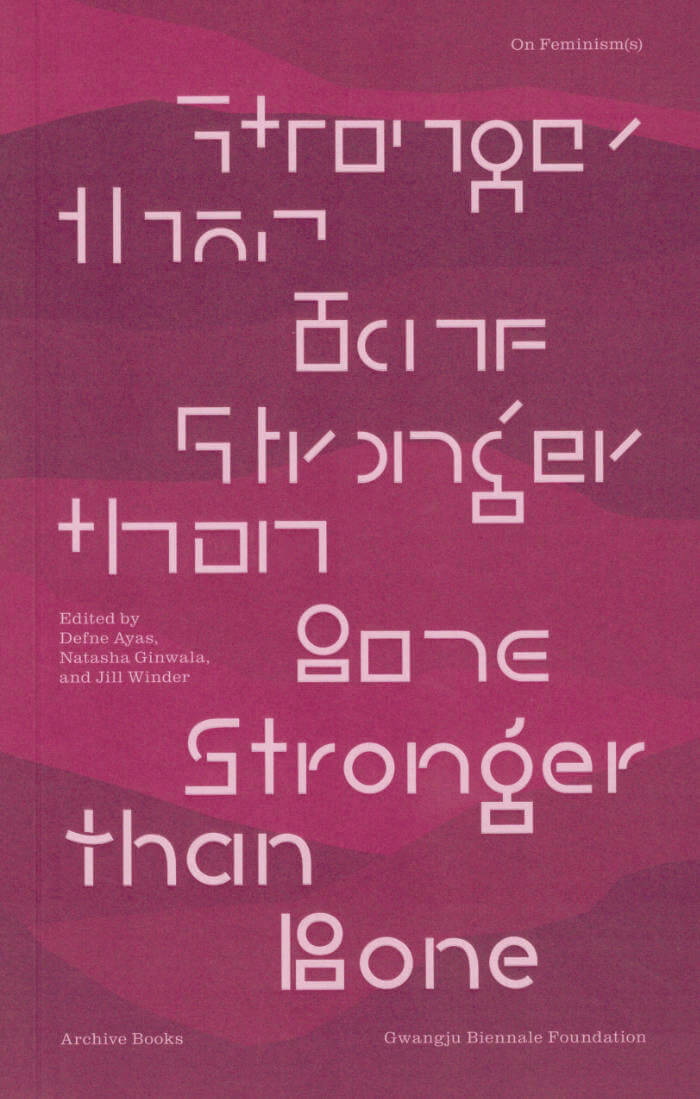
Stronger Than Bone – On Feminism(s)
Jill Winder, Natasha Ginwala and 1 more
Stronger than Bone draws upon the embodied strength, intuitive desires, and collective wisdom of feminists and non-binary protagonists to foreground the manifold dimensions of feminist politics and commitments.
Written by thinkers and allies across generations with a focus on heterogeneity, intersectionality, and influence across geographies, this reader arrives into the world at a moment of heightened fragility, under the shadow of the coronavirus pandemic. In key historical texts, poetry, and new commissions, a range of artists, theorists, philosophers, and writers grapple with how gender politics might be reconfigured in a world undergoing an interregnum of extraordinary intellectual, technological, political, artistic, and social ferment.
Stronger than Bone reveals strands of inquiry into a range of subjects including: embodiment and techno feminism; sexual freedom and sexual violence; matriarchal resistance building and shamanic practices; the gendered dimensions of self-optimization; digital identity and gaming culture; how the trauma of state violence and racial injustice is passed to future generations; and artistic strategies of renewal and rewriting history. With a view to the peril and possibility of the current moment, bringing together this constellation of voices is an act of acknowledging kinship, one iteration of the liberatory potential of collective forms of intelligence!
Contributions by Chris Abani, Gloria Anzaldúa, Wendy Hui Kyong Chun & Sarah Friedland, Tishani Doshi, Maya Indira Ganesh, Eeva-Kristiina Harlin & Ciske-Jovsset Biret Hánsa Outi/Outi Pieski, Laurel Kendall, Kim Hyesoon, Kim Seongnae, S. Heijin Lee, Audre Lorde, Soraya Murray, Esha Pillay & Quishile Charan, Djamila Ribeiro, Tamarra & Brigitta Isabella, Oxana Timofeeva, Cecilia Vicuña.
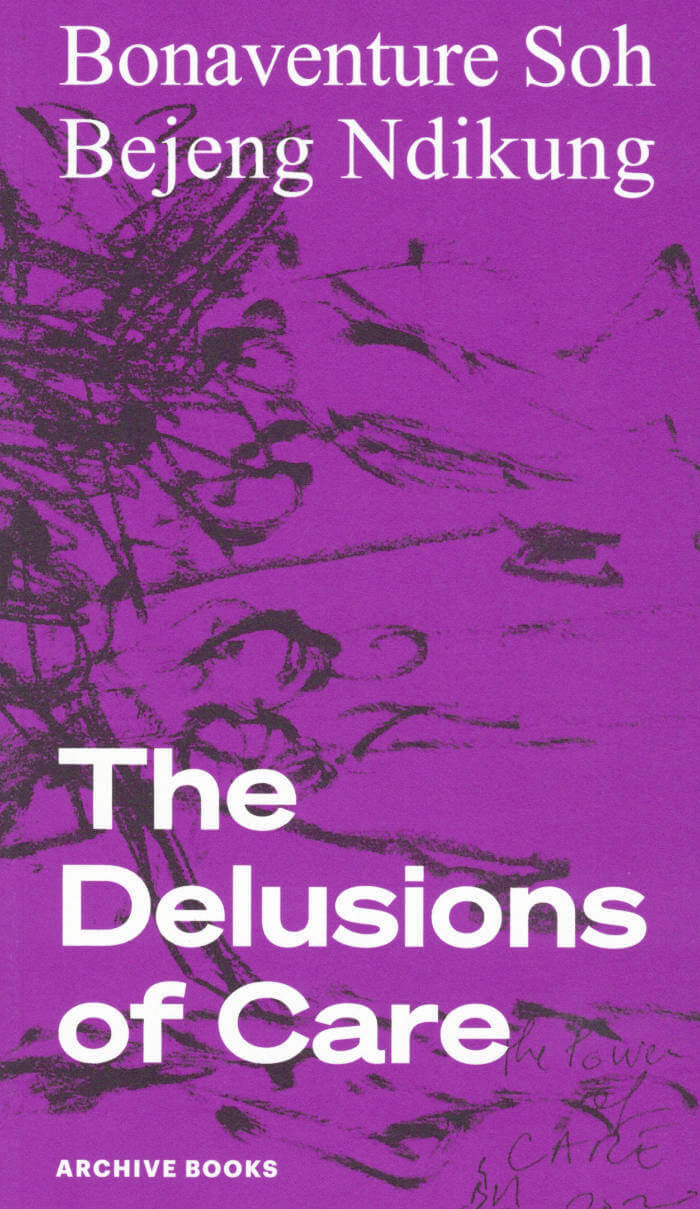
The Delusions of Care
Bonaventure Soh Bejeng Ndikung
The Delusions of Care is a culmination of three long essays that ruminate on notions of care in our contemporary and historically. It is concerned with the appropriation of care by the capitalist establishment as much as supremacists of all kinds. What can we consider as care and who gives care for what reasons. Stuck in the cup de sac of a pandemic that has brought most of the world to its knees, these questions seem of some pertinence. The reflections in this book spanning a critique of care from the regimes of birth control through police brutality to the storming of the Reichstag in the summer of 2020, that very much set precedence to the storming of the Capitol Hill by Trumpists and White supremacists. The book does not only point out the pitfalls of a corrupted notion of care, but tries to offer paths for rehabilitation, restoration, restitution through a non-selfish spirit of care.
This book is a manifesto in which love and crisis imbue each other with the spirit of care. Bonaventure Ndikung calls on those in its belly to seize the means of the production of caring from the beast of state power and corporate greed. —Arjun Appadurai
Bonaventure Soh Bejeng Ndikung (born 1977 in Yaoundé, Cameroon, lives and works in Berlin) is an independent art curator, art critic, author and biotechnologist. He is founder and artistic director of SAVVY Contemporary Berlin and editor-in-chief of SAVVY Journal for critical texts on contemporary African art.
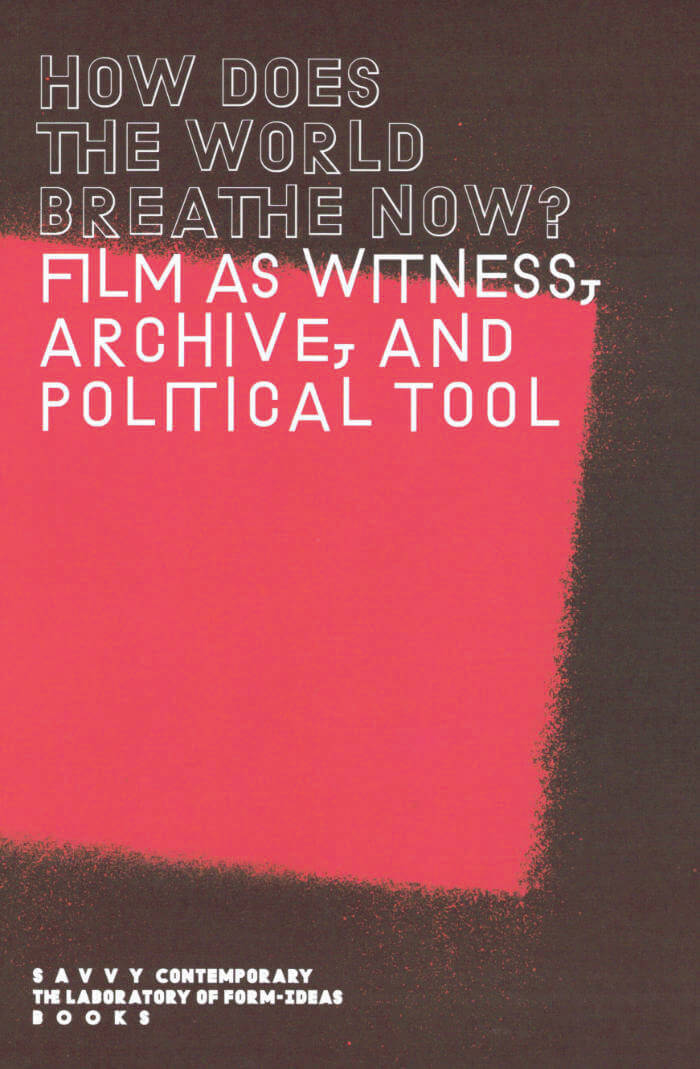
How Does The World Breathe Now? – Film as Witness, Archive, and Political Tool
Eirini Fountedaki, Pia Chakraverti-Würthwein
How film may be a constructive tool to examine the state of the world and its cruelties, and how to form a more stable and supportive culture of film production and distribution.
Out of frustration and exasperation with the state of the world in 1960, Indonesian poet Willibrordus Surendra Broto Rendra asked himself: "How does the world breathe now?"
The film series conceived of by SAVVY Contemporary, which ran from September 2016 through March 2018, was a response to our own dismay at the continued injustices that the world faces. Each week SAVVY invited a different speaker who would choose a film that she or he felt answered, or asked more questions of, the question, "how does the world breathe now?" More than just a series of screenings, the film series became a kind of ciné-club where we also ate, drank, and danced together, and out of which new concepts, collaborations, and polemics emerged. With this publication we hope to offer readers another mode of thinking about films, and to pick up on some loose threads or unfinished conversations of the film series.
Over the course of the publication's three sections: Bearing Witness: old & new filmic practices with political clout; Archiving, Preserving, and Accessing Film; and New Relationships, New Practices: Towards sustainable & ethical filmmaking, SAVVY brings together the voices of contributors such as Sarah Maldoror, Filippos Koutsaftis, the Spotters of the TRIBUNAL "Unraveling the NSU Complex," Stefanie Schulte Strathaus, Talal Afifi and Viola Shafik, the *foundationClass, and Olivier Marboeuf, among others. Together, we explore how film may be a constructive tool to examine the state of the world and its cruelties, and we ponder how to form a more stable and supportive culture of film production and distribution.
Contributions by Talal Afifi, Elena Agudio, Antonia Alampi, Ana Alenso, Alexander Apóstol, Iván Candeo, Pia Chakraverti-Würthwein, Haris Epaminonda, Eirini Fountedaki, Filippos Koutsaftis, Lal Laleş, Nikola Madzirov, Sarah Maldoror, Olivier Marboeuf, Marco Montiel-Soto, Bonaventure Soh Bejeng Ndikung, Erika Ordosgoitti, Rolando Peña, Franziska Pierwoss & Siska, Carlos Rebolledo, Stefanie Schulte Strathaus, Viola Shafik, Spotters.

We Have Delivered Ourselves From the Tonal – Of, Towards, On, For Julius Eastman
A collection of essays, librettos, lyrics, memories, photos, personal anecdotes by musicians, visual artists, researchers and archivers that pays homage to the work and life of African-American composer, musician, performer, activist Julius Eastman.
The book investigates his legacy beyond the predominantly Western musicological format of the tonal or harmonic and the framework of what is today understood as minimalist music. By trying to complicate, deny or expatiate on the notions of the harmonic, tonal hierarchy, the triadic, or even the tonal centre, Eastman's compositions explore strategies and technologies of attaining the atonal. One might be tempted to see Eastman in the legacy of Bartok, Schoenberg, Berg and others, but here too, it is worth shifting the geography of minimal tendencies and minimalism in music. It is worth listening and reading Eastman's music within the scope of what Oluwaseyi Kehinde describes as the application of chromatic forms such as polytonality, atonality, dissonance as the fulcrum in analysing some elements of African music such as melody, harmony, instruments and instrumentation. This publication constructs a non-linear genealogy of Eastman's practice and his cultural, political and social relevance, while situating his work within a broader rhizomatic relation of musical epistemologies and practices.
Julius Eastman (1940-1990) was an American composer, pianist, vocalist, and dancer whose work fell under minimalism. He was among the first composers to combine minimalist processes with elements of pop music.
Contributions by Talal Afifi, Elena Agudio, Antonia Alampi, Ana Alenso, Alexander Apóstol, Iván Candeo, Pia Chakraverti-Würthwein, Haris Epaminonda, Eirini Fountedaki, Filippos Koutsaftis, Lal Laleş, Nikola Madzirov, Sarah Maldoror, Olivier Marboeuf, Marco Montiel-Soto, Bonaventure Soh Bejeng Ndikung, Erika Ordosgoitti, Rolando Peña, Franziska Pierwoss & Siska, Carlos Rebolledo, Stefanie Schulte Strathaus, Viola Shafik, Spotters.

Whose Land Have I Lit on Now? – Contemplations on the Notions of Hospitality
Elena Agudio, Bonaventure Soh Bejeng Ndikung and 1 more
A curatorial project about concepts of hospitality and the triggers of hostility in hospitality.
The unlikely seemed possible in the summer of 2015, as thousands of immigrants from mostly Syria made their way to Germany and Angela Merkel made the statement "Wir schaffen das" (We can do it/ we can cope with it). A German's venture into open hospitality was being witnessed as the country celebrated its newfound "Willkommenskultur." Soon enough, however, the summer of grace became the autumn of rage and the winter of nightmares, as the initial goodwill turned into the resurgence of the extreme right in Germany. Much is happen- ing today that calls for a reflection on hospitality in Germany, in Europe, and in the world at large. Taking as a point of departure Derrida's notion of "hostipitality" – that is the presence of hostility in all hospitality and hosting–this anthology brings together original contributions from artists, scholars, activists, poets, curators, and musicians who reflect on different experi- ences and notions of hospitality.
In an age of flourishing resentments and antipathy towards all that seems conceptually or physically "strange"/ a "stranger," in a time when the historical violence of the guest (as a colonizer) over the host is reiterated and fortified; in an era that has turned hospitality into a neoliberal commodity, it becomes urgent to reconsider hospitality's gradients of power.
Contributions by Elena Agudio,Mohamed Amjahid, Ulf Aminde, Arjun Appadurai, Federica Bueti, Ibrahim Arslan, Joshua Chambers-letson, Bilgin Ayata, Jill Denton, Jihan El-tahri, Denise Ferreira Da Silva, Seloua Luste Boulbina, Raisa Galofre, Lionel Manga, Peter Morin, Massimo Perinelli, Naeem Mohaiemen, Miriam Schickler, Farkhondeh Shahroudi, Safiya Sinclair, Bonaventure Soh Bejeng Ndikung, Denise Ryner, Margarita Tsomou, Tania Willard.
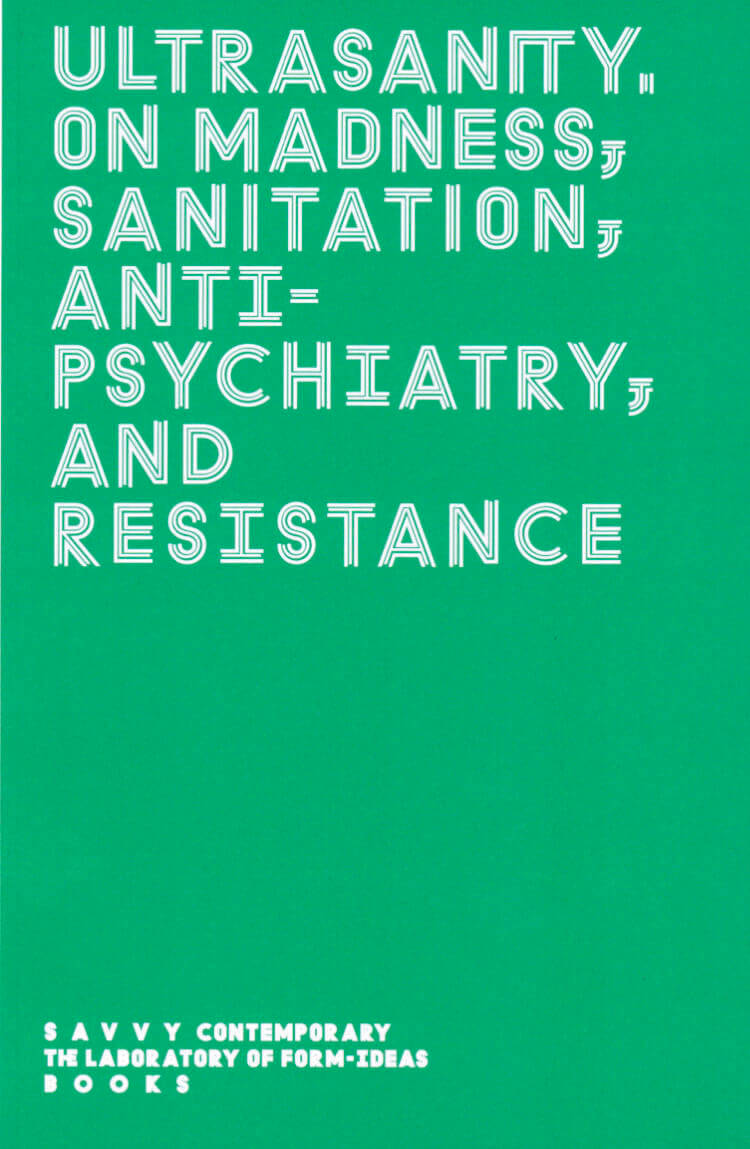
Ultrasanity – On Madness, Sanitation, Antipsychiatry, and Resistance
Kelly Krugman, Elena Agudio and 1 more
A curatorial and research project that aims to move beyond insanity as the opposite of sanity, and imagine a space beyond what is understood as sane, i.e. ultrasanity—not a romanticization of madness or mental illness, but an effort to reconsider and challenge the notion of madness and the stigmas labelled on the so-called mad.
This publication unfolds as a collection of words, works, and images that informed, incited, and embodied SAVVY Contemporary's project Ultrasanity. On Madness, Sanitation, Antipsychiatry, and Resistance, an exhibition and research project on the elasticity of sanity.
It doesn't materialise simply as a catalogue of the exhibition but as a book retracing the trajectory of a research, as an occasion to extend SAVVY's curatorial proposition into a further choral perspective. With it we aim to deepen some of the reflections that moved and agitated us through two years of researches, conversations, programming, and practicing of Ultrasanity. The cogitations and the confrontations, the movements and the sounds, the trials and the tribulations, that accompanied us through the project and its 4 chapters and iterations are here collected to resonate one to each other, and to open new trajectories and paths.
Contributions by Hortensia Völckers, Kirsten Ha, Alya Sebti, Inka Gressel, Joerg Fingerhut, Ana Gómez-Carillo, Bonaventure Soh Bejeng Ndikung, Elena Agudio, Frederick W. Hickling, Debbie-Ann Chambers, Jaswant Guzder, The Brother Moves On, Jota Mombaça, Ghayath Almadhoun, Dora García, Monica Greco, Sajdeep Soomal, Ayesha Hameed, Jaswant Guzder, Johan Lagae, Sofie Boonen, Maarten Liefooghe, Mpho Matsipa, Dorothee Munyaneza.

On the Run – Perspectives on the Cinema of Med Hondo
A tribute.
A pioneer of African cinema and author of an uncompromising, strong and diverse oeuvre, we have come to know and appreciate Med Hondo over the decades as one who simultaneously gazes, belligerently and attentively, sharply, passionately and ironically, deep into the past, precisely at the present, but also far into the future. On the Run, Perspectives on the Cinema of Med Hondo features contributions that pay tribute to Med Hondo's films. This publication examines Hondo's work, which is often focused on the production of history and its practice from an African perspective, taking into account the temporality of the narratives in his work.
Contributions by Jean-Pierre Bekolo, Madeleine Bernstorff, Kudzanai Chiurai, Ute Fendler, Abrie Fourie, June Givanni, Med Hondo, Boudjemaâ Karèche, Astrid Kusser Ferreira, Seloua Luste Boulbina, Shaheen Merali, Pascale Obolo, Abdoulaye Souleye, Françoise Vergès, Ibrahima Wane.
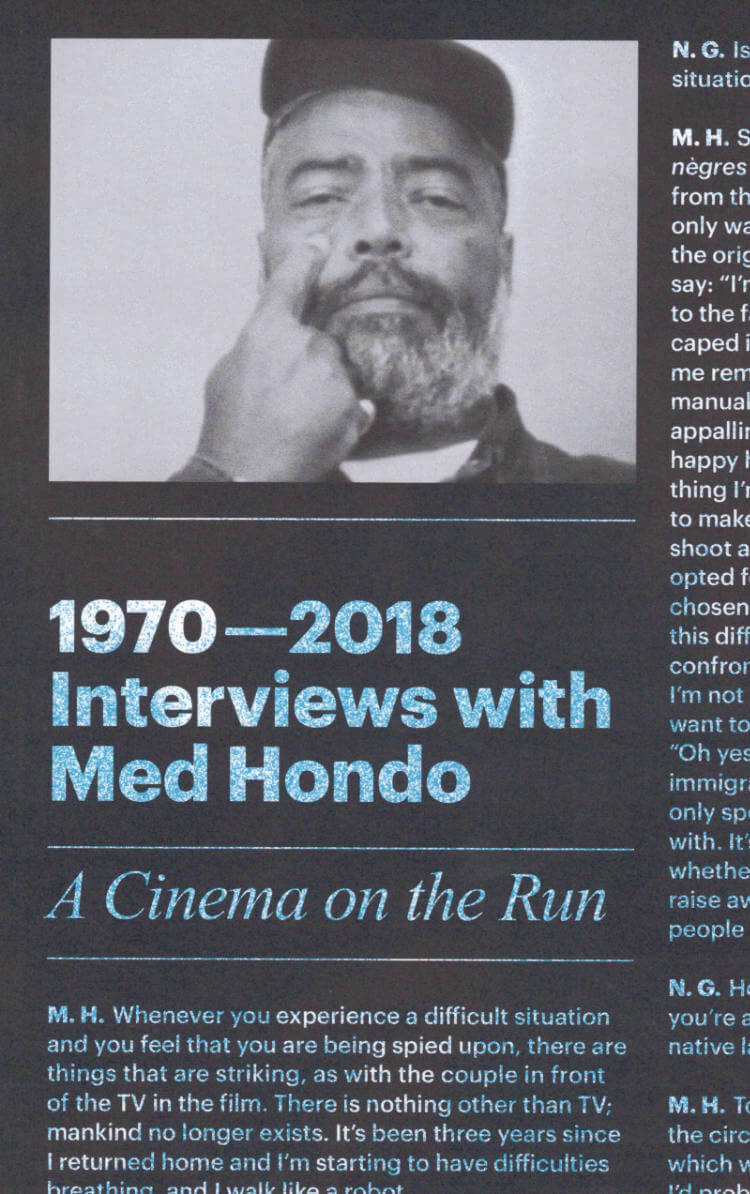
1970—2018 – Interviews with Med Hondo
Seventeen interviews conducted with Med Hondo over a period of almost half a century, most of the interviews originally published in French were translated into English.
To read Med Hondo opens us up to many perspectives: to his work and its time-historical contexts, to his interests and obsessions, to his standpoint with regard to the intertwining of politics, economics, and culture. Med Hondo describes the school of pronunciation until such point as the slightest accent is erased; he observes the insults immigrants in France have had to tolerate, and fuses their stories and histories with the present; he builds bridges to the Caribbean and to the Western Sahara, to Algeria and Burkina Faso, to Niger and Senegal, to South Africa and the USA. This publication aims to draw attention to Med Hondo's cinema and legacy.
The book originated in the long-term project Cours, cours, camarade, le vieux monde est derrière toi—Run, comrade, run, the old world is behind you—The Cinema of Med Hondo.
Franco-Mauritanian director, screenwriter, producer and actor, also known for his work in dubbing, Med Hondo (1936-2019) is one of the great figures of African cinema. His militant work denounces neo-colonialism, racism, the rupture between the peoples of Africa, immigration policies and the resulting social violence.
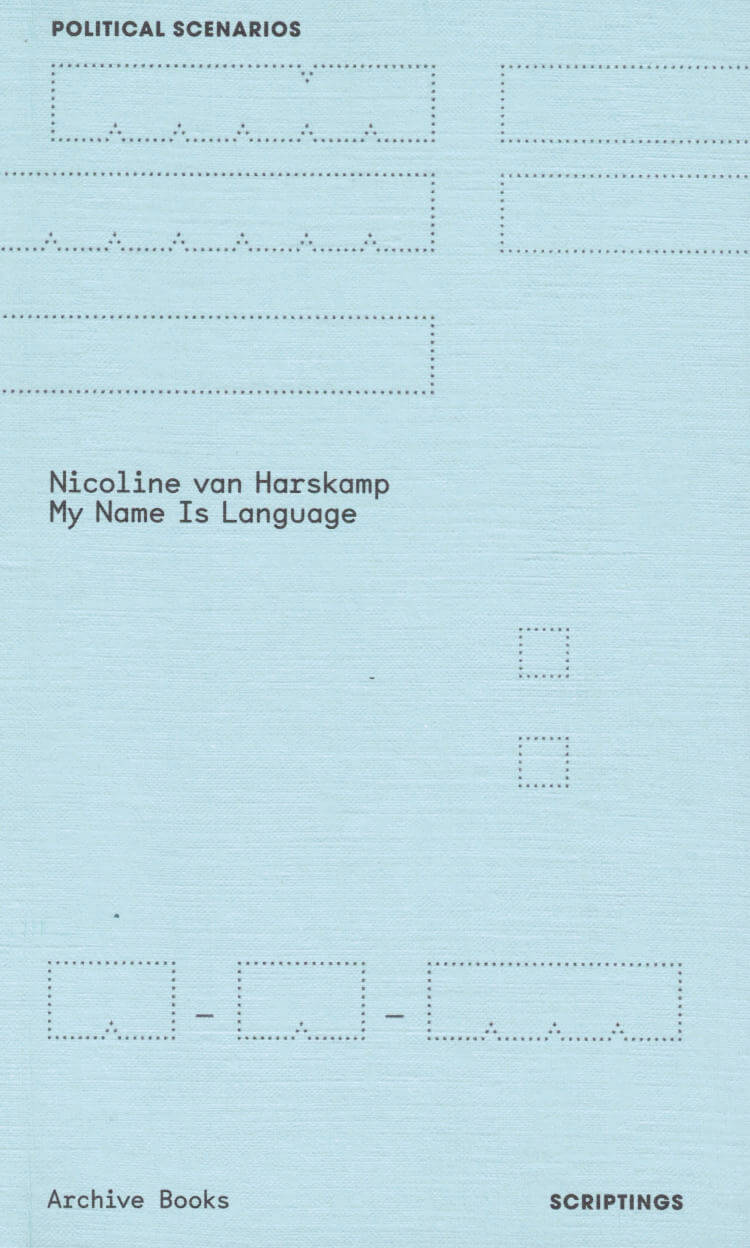
My Name is Language
This publication explores the key tenets of artist Nicoline van Harskamp's research and practice, such as the contemporary use and modification of languages, a treatment of names as spoken language rather than spelled identity markers, and the practice of self-naming.
In the fictive worlds represented in this book, society is not centralized, not oversized, and self-naming is brought forward as a form of self-empowerment and resistance.
Central to this book are scripts by Nicoline van Harskamp, for the video work PDGN and a series of staged works titled My Name Is Language. A scholar of literary arts and performance culture, Avishek Ganguly reflects in his essay "Global Englishes, Rough Futures" on questions of translation, incomprehension, and untranslatability in van Harskamp's work. The book also includes a list of text-change algorithms that van Harskamp calls "distorters" and an excerpt from Woman on the Edge of Time (1976) by Marge Piercy.
Nicoline van Harskamp (born 1975 in Hazerswoude, Netherlands, lives and works in Amsterdam) is an artist whose work considers acts of language and solidarity, focusing on the constant evolution of spoken language, and its inevitable divergence from hegemonic norms. All of her works have a performative character and take the form of live staging, video, installations, and even publications, since her working process is characterised by the transformation of speech to writing and the other way around. She has presented her work and staged live pieces at art institutions, museums and the Internationally.

Delta — An Ocean Call
Pontus Pettersson, Izabella Borzecka
Delta is a coming together for choreographic and performative work to be shared and exercised, a place for sharing work by doing the work. A container for participatory projects, dancing, exchange and choreographic inquiries. Delta is organised as evening dance classes, artist zines and thematic publications, like this one: On water histories, narratives and practices.
Water both divides and merges, varies and manifests in different kinds of shapes and structures, acquiring different relations with its surroundings. As a transformative material, could one say that water has a different kind of logic, another kind of dance? In this publication, the contributors Bronwyn Bailey-Charteris, Paul Maheke, Axel Andersson, Sindri Runudde, Vibeke Hermanrud, Elly Vadseth, Daniela Bershan, Sabrina Seifried, D.N.A. (Dina El Kaisy Friemuth, Neda Sanai and Anita Beikpour), Every Ocean Hughes, Adham Hafez, Pontus Pettersson, and Alice MacKenzie share their multi-layered practices, writings, memories and scores on water. Inviting you to submerge!
With contributions by: Bronwyn Bailey-Charteris, Paul Maheke, Axel Andersson, Sindri Runudde, Vibeke Hermanrud, Elly Vadseth, Daniela Bershan, Sabrina Seifried, D.N.A. (Dina El Kaisy Friemuth, Neda Sanai and Anita Beikpour), Every Ocean Hughes, Adham Hafez, Pontus Pettersson and Alice MacKenzie.
Bronwyn Bailey-Charteris: First Move, Original Rains: a Score for Sensing the Precipitational
Pontus Pettersson: Dripping from my fingertips
Adham Hafez: To dance about nature?
Daniela Bershan in collaboration with Sabrina Seifried: Mapping OCEAN
Sindri Runudde: Chosen by the barnacles
Vibeke Hermanrud in conversation with Elly Vadseth: Submerged
Axel Andersson: Confessions of a swimmer
D.N.A: Hydrocapsules.love
Paul Mahek:e As the Waters Recall
Alice MacKenzie: I know that smell
Every Ocean Hughes: Ocean
Pontus Pettersson: 100 ways of water
Graphic design by Sara Kaaman
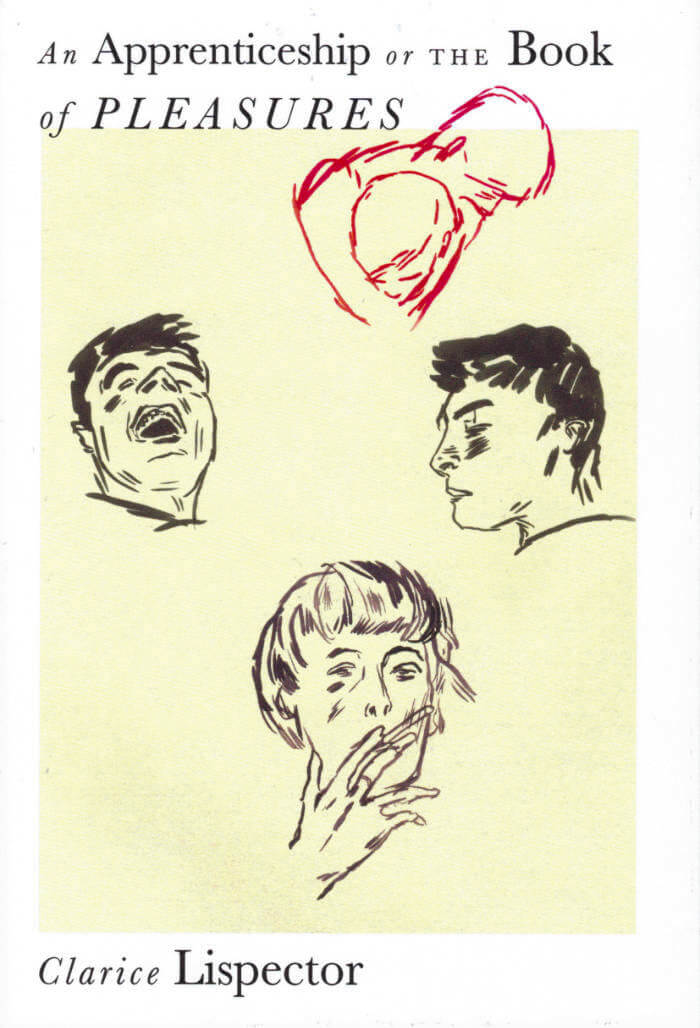
An Apprenticeship or the Book of Pleasures
In An Apprenticeship or The Book of Pleasures, Clarice Lispector tries to discover how to bridge the gap between people, or how to even begin to try.
A woman struggles to emerge from solitude and sadness into love, including sexual love: her guide on this journey is Ulisses, who (yes) leads her patiently into the fullness of life. An Apprenticeship was a bestseller and, as her biographer Benjamin Moser writes, this accessible love story surprised many readers. When it came out, an interviewer said: 'I thought The Book of Pleasures was much easier to read than any of your other books. Do you think there's any basis for that?' Clarice answered: 'There is. I humanized myself, the book reflects that.'"
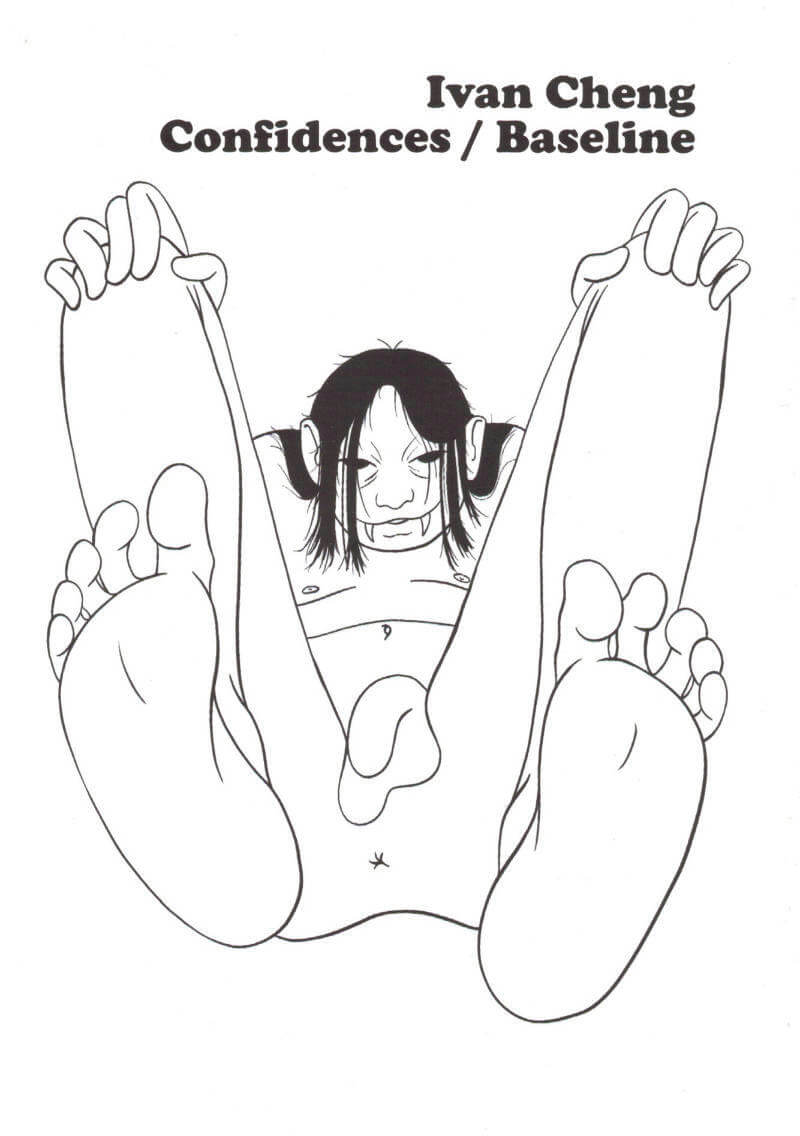
Confidences / Baseline
Confidences / Baseline plays with the vampire novel like a dollhouse. Characters who variously believe in the power of theatre and performance become entangled with grief, desire, and the unknown. What does a rehearsal come to mean when a vampire lives forever?
Baseline is the first in a series of books that fetishise nightclubs for their inaccessibility. Deluded realities anticipate the transformative sensuality of penetration. In his second novel, artist Ivan Cheng maintains his fixation on structures for audiences between public and private.
Designed by Sabo Day
Book cover by Özgür Kar
Back cover photography by Nikola Lamburov
TLTRPreß, Berlin 2021
ISBN: 978-3-9819640-5-9
176 pages, 117 x 164mm, edition of 40,2kg
About Ivan Cheng:
The performances of Ivan Cheng are incomplete, failing, desperate, and riddled with absence. They use his variously trained performing body, incanting texts that foreground subjectivity in monologues and dialogues. Identities of other interlocutors become embedded through rehearsal, dialogue, and entrustment. Without deluded presupposition of being for everyone, Cheng’s practice is invested in questions around publics and accessibility.
In 2020, he reconstituted past performance texts into a murder mystery about a street busker, and continues his foray into written genre with Confidences / Baseline. Past presentations of his texts have occurred at Volksbühne (Berlin), Oude Kerk (Amsterdam), Belvedere21 (Vienna), MuHKA (Antwerp), Nacionalinė dailės galerija (Vilnius), Unsound Festival (Krakow), Carriageworks (Sydney), Federation Square (Melbourne). He holds an MFA in Critical Studies (Sandberg Instituut), having previously studied at the Royal Academy of Music and Sydney Conservatorium of Music.
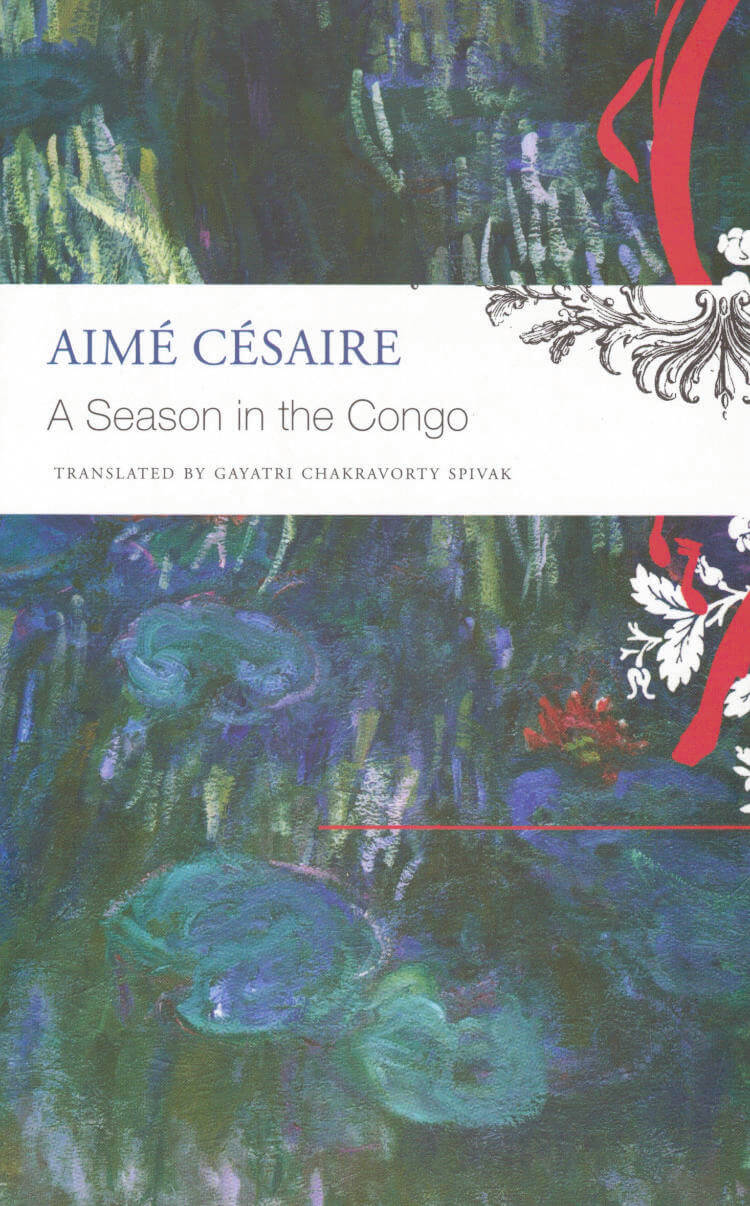
A Season in the Congo
This play by renowned poet and political activist Aime Césaire recounts the tragic death of Patrice Lumumba, the first prime minister of the Congo Republic and an African nationalist hero. A Season in the Congo follows Lumumba's efforts to free the Congolese from Belgian rule and the political struggles that led to his assassination in 1961. Césaire powerfully depicts Lumumba as a sympathetic, Christ-like figure whose conscious martyrdom reflects his self-sacrificing humanity and commitment to pan-Africanism.
Born in Martinique and educated in Paris, Césaire was a revolutionary artist and lifelong political activist, who founded the Martinique Independent Revolution Party. Césaire's ardent personal opposition to Western imperialism and racism fuels both his profound sympathy for Lumumba and the emotional strength of A Season in the Congo.
Now rendered in a lyrical translation by distinguished scholar Gayatri Chakravorty Spivak, Césaire's play will find a new audience of readers interested in world literature and the vestiges of European colonialism.

Parable of the Sower
When global climate change and economic crises lead to social chaos in the early 2020s, California becomes full of dangers, from pervasive water shortage to masses of vagabonds who will do anything to live to see another day. Fifteen-year-old Lauren Olamina lives inside a gated community with her preacher father, family, and neighbors, sheltered from the surrounding anarchy. In a society where any vulnerability is a risk, she suffers from hyperempathy, a debilitating sensitivity to others' emotions. Precocious and clear-eyed, Lauren must make her voice heard in order to protect her loved ones from the imminent disasters her small community stubbornly ignores. But what begins as a fight for survival soon leads to something much more: the birth of a new faith . . . and a startling vision of human destiny.
With a new foreword from award-winning author N. K. Jemison.
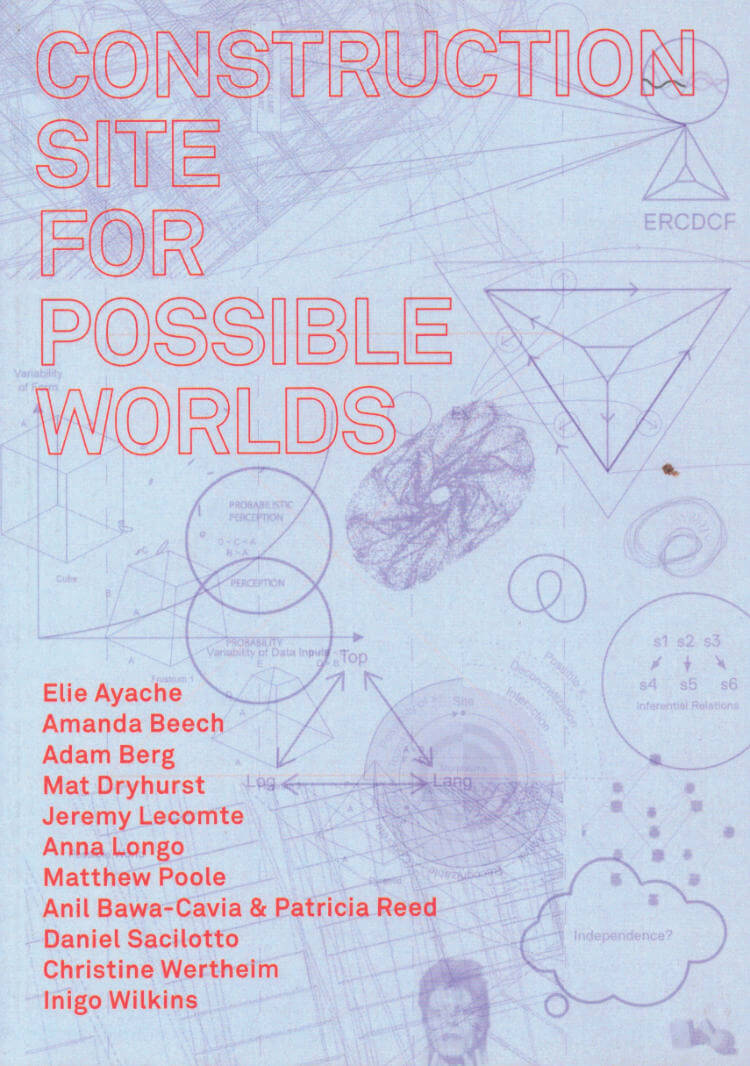
Construction Site For Possible Worlds
James Wiltgen, Robin MacKay and 1 more
Perspectives from philosophy, aesthetics, and art on how to envisage the construction site of possible worlds.
Given the highly coercive and heavily surveilled dynamics of the present moment, when the tremendous pressures exerted by capital on contemporary life produces an aggressively normative "official reality," the question of the construction of other possible worlds is crucial and perhaps more urgent than ever.
This collection brings together different perspectives from the fields of philosophy, aesthetics, and art to discuss the mechanisms through which possible worlds are thought, constructed, and instantiated, forcefully seeking to overcome the contemporary moment's deficit of conceptualizing alternate realities—its apparent fear of imagining possible new and compelling futures—to begin the arduous task of producing the political dynamics necessary for actual construction.
Implicit in this dynamic between the imaginary and the possible is the question of how thinking intertwines with both rationality and the inherited contingencies and structures of the world. With no ascertainable ground on which to build, with no confidence in any given that could guarantee our labors, how do we even envisage the construction site(s) of possible worlds, and with what kind of diagrams, tools, and languages can we bring them into being?
Amanda Beech is an artist and writer based in Los Angeles.
Robin Mackay is a philosopher, Director of the UK arts organization Urbanomic, and Associate Researcher at Goldsmiths University of London.
James Wiltgen is a Lecturer at the California Institute of the Arts.
Inigo Wilkins is Codirector of Glass Bead. He has published articles on sonic culture and other topics in such journals as Litteraria Pragensia, Mute Magazine, and HFT Review.
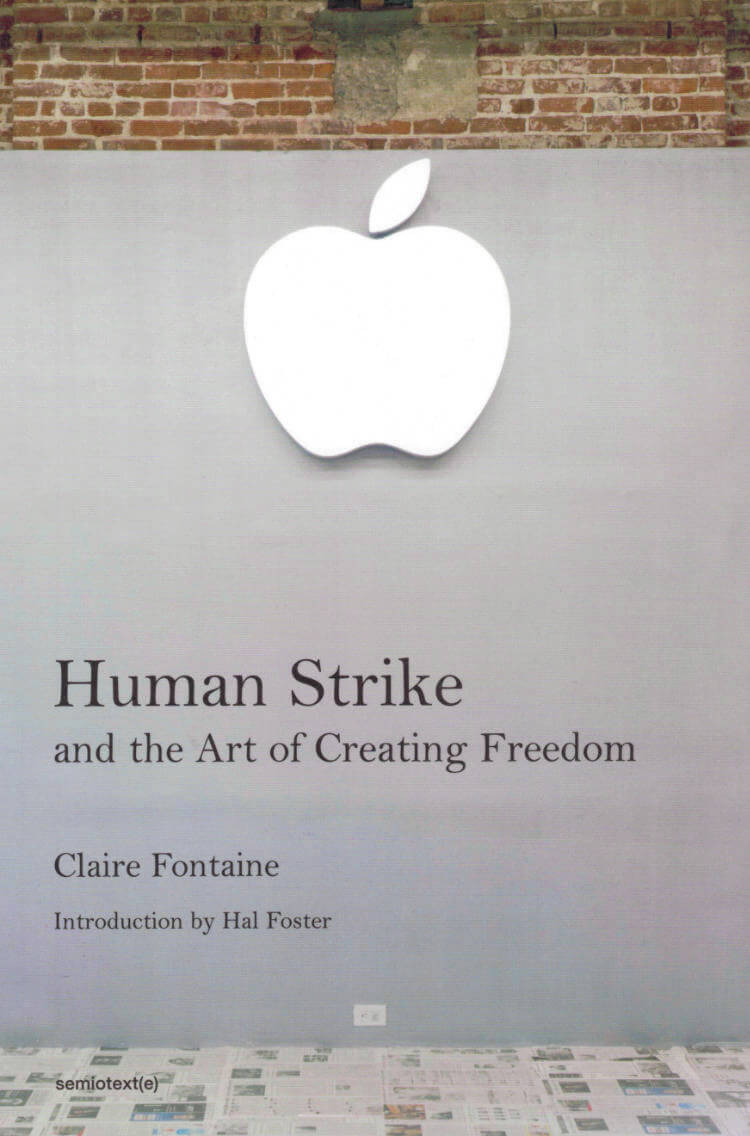
Human Strike and the Art of Creating Freedom
The first English-language publication of writings by the collective artist Claire Fontaine, addressing our complicity with anything that limits our freedom.
This anthology presents, in chronological order, all the texts by collective artist Claire Fontaine from 2004 to today. Created in 2004 in Paris by James Thornhill and Fulvia Carnevale, the collective artist Clare Fontaine creates texts that are as as experimental and politically charged as her visual practice. In. these writings, she uses the concept of "human strike" and adopts the radical feminist position that can be found in Tiqqun, a two-issue magazine cofounded by Carnevale.
Human strike is a movement that is broader and more radical than any general strike. It addresses our inevitable subjective complicity with everything that limits our freedom and shows how to abandon these self-destructive behaviors through desubjectivization. Human strike, Claire Fontaine writes, is a subjective struggle to separate from the inevitable harm we do to ourselves and others simply by living within postindustrial neoliberalism. Human Strike is the first English-language publication of Claire Fontaine's influential and important theoretical writings.
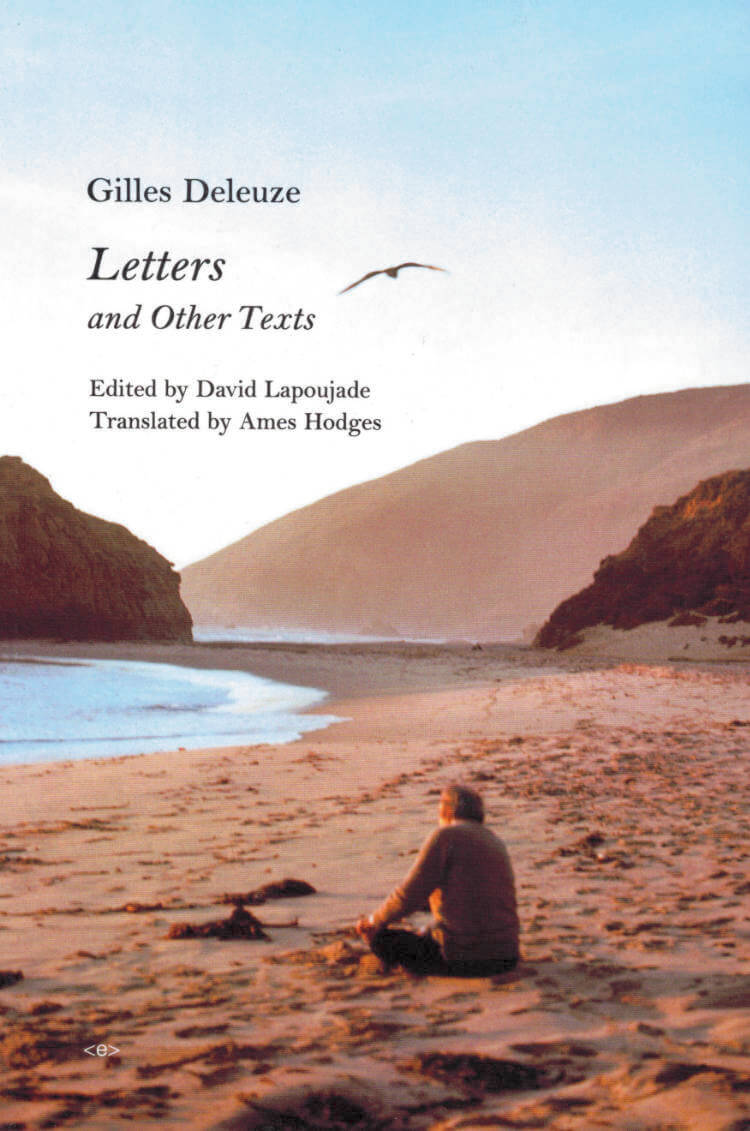
Letters and Other Texts
A posthumous collection of writings by Deleuze, including letters, youthful essays, and an interview, many previously unpublished.
Letters and Other Texts is the third and final volume of the posthumous texts of Gilles Deleuze, collected for publication in French on the twentieth anniversary of his death. It contains several letters addressed to his contemporaries (Michel Foucault, Pierre Klossowski, François Châtelet, and Clément Rosset, among others). Of particular importance are the letters addressed to Félix Guattari, which offer an irreplaceable account of their work as a duo from Anti-Oedipus to What is Philosophy? Later letters provide a new perspective on Deleuze's work as he responds to students' questions.

Errare
ERRARE/WANDERING/WONDERING is a publication by Lucia Palladino that brings together exercises and notes for wild outdoor walking practices in Contemplative Activism. This publication can be used for improvisation and choreographic composition for dancers and actors, but can also be used by everyone as maps for disorientation and deep listening.
Contemplative Activism is an ongoing research in decolonizing, anti-capitalistic practices for the body in relations to the landscape they are immersed in. You find the manifesto of CA inserted in the publication.
Concept and words by Lucia Palladino
Design by Marzia Dalfini
Proofreading by Sarah Cale
Bookbinding by La Rivière Sèche and Lucia Palladino
Co-produced by Nadine for the WAB 2021.